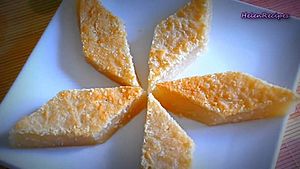Bánh khoai mì facts for kids
 |
|
| Type | Cake |
|---|---|
| Course | Dessert, snack |
| Place of origin | Vietnam |
| Region or state | Southeast Asia |
| Main ingredients | Cassava, Sugar, Coconut Milk |
| Variations | Bánh khoai mì nướng, Bánh khoai mì hấp |
| Similar dishes | Cassava cake, Bibingka, Pilawpinan mont |
Bánh khoai mì is a delicious Vietnamese cake. It's made from grated cassava, which is a starchy root vegetable. Other key ingredients include sugar, creamy coconut milk, and a tiny bit of salt. This sweet treat is a popular dessert or snack in Vietnam.
What is Bánh Khoai Mì?
Bánh khoai mì is a special kind of cake that uses cassava as its main ingredient. Cassava is a root vegetable, a bit like a potato, that grows in warm, tropical places around the world. It's a very important food source for many people. To make this cake, the cassava is grated into small pieces. Then, it's mixed with sugar to make it sweet and coconut milk to give it a rich, creamy flavor. A little salt is added to balance out the sweetness.
Two Ways to Make This Cake
There are two main ways to prepare Bánh khoai mì, which changes its texture and taste:
- Bánh khoai mì nướng
This type means "baked cassava cake." It's cooked in an oven until it turns a lovely golden brown color. The outside becomes a bit crispy, while the inside stays soft, chewy, and moist. This baked version is the most common and popular way to enjoy Bánh khoai mì.
- Bánh khoai mì hấp
This type means "steamed cassava cake." Instead of baking, this version is cooked by steaming. It results in a cake that is very soft and moist, without any crispy edges. The steamed version is less common but still enjoyed by some.
How is it Different from Other Cakes?
Bánh khoai mì is similar to some other cakes made from root vegetables. For example, a cake made from taro (another root vegetable) is called bánh khoai môn in Vietnam.
It also shares similarities with the cassava cake from the Philippines. Both cakes use cassava as their main ingredient. However, there are a few differences:
- The Filipino cassava cake often has a special top layer, which is usually a creamy custard.
- The Filipino version also commonly uses regular milk as an ingredient, while Bánh khoai mì traditionally relies on coconut milk for its creamy texture.
These small differences give each cake its own unique taste and feel, even though they both come from the humble cassava root!

